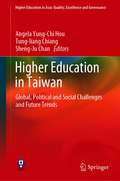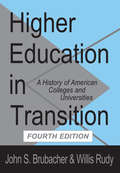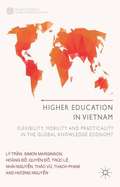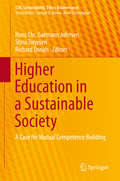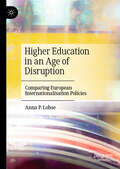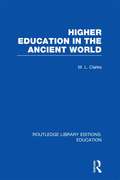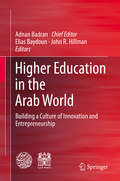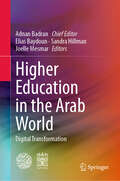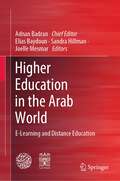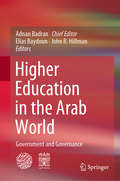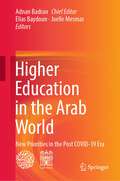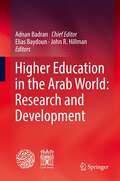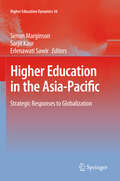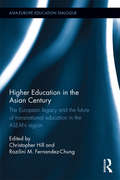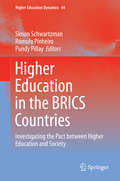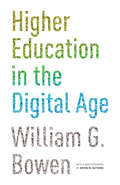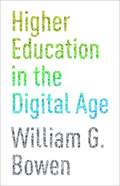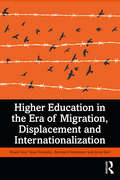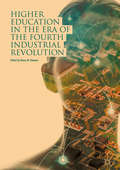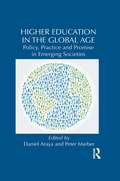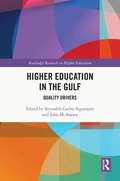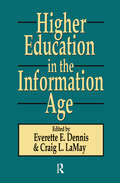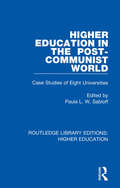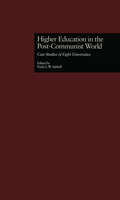- Table View
- List View
Higher Education in Taiwan: Global, Political and Social Challenges and Future Trends (Higher Education in Asia: Quality, Excellence and Governance)
by Sheng-Ju Chan Angela Yung-Chi Hou Tung-Liang ChiangThis book discusses the situation of Taiwanese universities facing a rapidly changing domestic and global environment. It examines the social structure, drawing on professional perspectives, data-based and systematic analysis. The book fills gaps in the literature of higher education systems in East Asia, of which Taiwan is a representative nation. It provides the readers with great opportunities to understand the historical, political and cultural background of the higher education system in Taiwan and shares Taiwan’s experience of how higher education institutions respond to the new challenges such as an ageing society, the pursuit of equity and inclusion, execution of talent recruitment, and the use of technological innovation. Finally the book discusses the implication of institutional research in university governance.
Higher Education in Transition: History of American Colleges and Universities
by John BrubacherAt a time when our colleges and universities face momentous questions of new growth and direction, the republication of Higher Education in Transition is more timely than ever. Beginning with colonial times, the authors trace the development of our college and university system chronologically, in terms of men and institutions. They bring into focus such major areas of concern as curriculum, administration, academic freedom, and student life. They tell their story with a sharp eye for the human values at stake and the issues that will be with us in the future.One gets a sense not only of temporal sequence by centuries and decades but also of unity and continuity by a review of major themes and topics. Rudy's new chapters update developments in higher education during the last twenty years. Higher Education in Transition continues to have significance not only for those who work in higher education, but for everyone interested in American ideas, traditions, and social and intellectual history.
Higher Education in Vietnam
by Simon Marginson L� Th? Tr?n Ho�ng Minh � Quy�n Th? Ng?c �? Tr�c Th? Thanh L� Nh�i Th? Nguy?n Th?o Th? Phuong Vu Th?ch Ng?c Ph?m Huong Th? Lan Nguy?n Ti�n Th? H?nh H?Higher and tertiary education have become crucial to modern economies and societies. As a nation, Vietnam has great potential and its secondary school students perform very well in comparative international tests, yet its universities and colleges are poor-performing, under-funded and slow to change compared to those in neighbouring East Asian nations like China and South Korea. Why is this the case - and what can be done about it? Higher Education in Vietnam dissects the problems and provides constructive and well-located solutions, combining reform with Vietnam's strong educational tradition, for the transformation of higher education in governance, funding, curriculum, quality assurance, internationalization, language policy, research and vocational training. Written by a team of expert insiders with international experience, this book is the first comprehensive diagnosis and prescription for higher education in Vietnam and establishes a distinctive Vietnamese pathway for modernization in the global knowledge economy.
Higher Education in a Sustainable Society
by Richard Ennals Hans Chr. Garmann Johnsen Stina TorjesenThis book addresses the following question: What is a sustainable society, and how can higher education help us to develop toward it? The core argument put forward is that the concept of sustainability reaches much farther than just the direct aspects of environmental threats and carbon emissions. Using higher education as a point of departure, the book shows that sustainability involves a broad range of disciplines, from nursing and nutrition to technology and management. It argues that a sustainable society entails a distinct perspective on society that influences our social thinking in terms of ethics, democracy and knowledge development. The book also discusses if (and if so, how) higher education can and should contribute to such a development based on the principles of the freedom of science in a liberal, democratic society. The book presents Mutual Competence Building as a concept higher education can adapt in order to contribute to a sustainable Society.
Higher Education in an Age of Disruption: Comparing European Internationalisation Policies
by Anna P. LohseThis book investigates European higher education internationalisation policies during a period marked by extreme upheaval due to Brexit and the COVID-19 pandemic. Situating her analysis at the intersection of higher education research and policy studies, the author combines historical and sociological institutionalism to investigate how this time of disruption impacted higher education policies in England, France and Germany. Based on extensive qualitative data derived from expert interviews and document analysis, the study offers timely insights into dynamics of institutional change and stability in higher education governance, as well as implications for the future of cross-border education and internationalisation. The book will appeal to academics and students interested in education policy and the internationalisation of higher education.
Higher Education in the Ancient World (Routledge Library Editions: Education)
by M L ClarkeThis volume provides an authoritative survey of Greek and Roman education above the primary school level from the fourth century B.C onwards. Special attention is given to the teaching of philosophy, and there are also chapters on the liberal arts, in particular grammar and rhetoric, and on professional education. School organization, teaching methods and the impact of Christianity and the Church as an educational institution are all discussed. The picture that emerges is one of an established educational system which continued for centuries with little change and survived even the challenge of Christianity.
Higher Education in the Arab World: Building a Culture of Innovation and Entrepreneurship
by Elias Baydoun John R. Hillman Adnan BadranThis book is the first major account of innovation and entrepreneurship in the Arab higher-education sector. It provides an update of the current situation and advances reasons for the under-performance of Arab universities in international ranking tables and the weaknesses of Arab economies. Specific proposals are made for upgrading curricula and assessment procedures as well as providing an environment that fosters innovation and entrepreneurial behaviour. The roles of university-based technology and business parks are examined, with examples of successful business partnerships in the Arab region, Europe, and North America.Opportunities for innovation and entrepreneurship have never been greater with the wealth of rapidly developing transformative technologies that are driving the international knowledge economy. This book puts forward proposals for the management and exploitation of intellectual property, and for establishing businesses.
Higher Education in the Arab World: Digital Transformation
by Elias Baydoun Adnan Badran Joelle Mesmar Sandra HillmanThis book provides a comprehensive insight and roadmap to accelerate the implementation of digital transformation (DX) within Arab Universities along with an understanding of the challenges that accompany such change. It explores the elements of DX in universities and presents case studies and experiences from Arab Universities along with recommendations that facilitate the use of DX in higher education. Within the Arab region, the potential for digitization within the higher education landscape has significant outcomes and impacts on the growth, progression, and development of this sector. Digital transformation allows universities to respond to change while fostering a student-centered approach and remaining relevant to the growing demands of the twenty-first century. It also improves the universities activities such as teaching and learning, curricula development and implementation, processes, operations, support services, and infrastructure. This increases the university’s competitive advantage locally and internationally. Embracing and adopting DX requires a paradigm shift in a university’s strategy and culture. The Arab world is home to more than 1,000 universities and in excess of 13 million students, and its higher education system offers a diverse range of undergraduate and postgraduate programs. To continue our series of books on higher education, we propose that the theme of this 8th book should be “Higher Education in the Arab World: Digital Transformation” in universities. In a complex regional and global climate, this book provokes a rich exploration of ideas around the challenges surrounding this sector and how to address them.
Higher Education in the Arab World: E-Learning and Distance Education
by Elias Baydoun Adnan Badran Joelle Mesmar Sandra HillmanThis book provides a comprehensive insight into the benefits and advantages of adopting technology-driven learning as a central pillar of the universities’ teaching, learning, research, and social-responsibility strategies. Despite the importance of adopting technology-enhanced learning within higher education institutions, Arab countries are still slow to change. Arab Universities are facing the need to adopt new methods of learning to serve the demands of a changing demography in the higher education community as well as the requirements of Industry 4.0 and Society 4.0. E-Learning and distance education are not just about technology, but they are about education, pedagogy, curriculum design, research, and innovation. The book also discusses the best methods to implement these modes of learning while taking into consideration all the hurdles and challenges specific to the Arab world. The needs of students (undergraduate and postgraduate), faculty, and the university at large are considered while drawing on the best quality-assurance practices to ensure the quality of education remains uncompromised. Also featured in this book are experiences from Arab Universities and recommendations for improvements that facilitate the use of education technology tools as part the university’s pedagogy to harness the full potential for implementing e-learning and distance education.
Higher Education in the Arab World: Government and Governance
by Elias Baydoun John R. Hillman Adnan BadranThis book examines the unsatisfactory situation in the Arab world where there is a pressing need to address poverty, unemployment, political instability, corruption, and the existential threat of climate change. The authors analyze the relationships between universities and governments in the Arab world, and make recommendations that will help develop intellectual capacity and thereby aid the economic and social transitions so desperately needed in all Arab countries. Countries aspiring to participate fully in the global knowledge economy require dynamic university sectors operating in concert with governments that actively promote high-quality education and research and foster innovation and entrepreneurship. Successful university-government relationships can be complex and are continually evolving.
Higher Education in the Arab World: New Priorities in the Post COVID-19 Era
by Elias Baydoun Adnan Badran Joelle MesmarThis book presents selected case studies from the Arab world on the universities responses to the pandemic. This book will look in detail at the priorities of the higher education sector in the post-COVID-19 era and the changes that must be adopted by universities and governments. These changes will allow the higher education sector to emerge from the crisis and build short- and long-term resilience.The onset of the COVID-19 pandemic has induced sudden changes worldwide by setting a global lockdown that has impacted all industries and sectors, affecting our daily lives and forcing us to adapt to a new normal. This book is the first major account of how the pandemic has shaken universities and higher education institutions in the Arab world today and tomorrow. Crucially, it examines the responses of universities to COVID-19, highlights their current position, and addresses the negative and positive outcomes. Has this crisis become an adversity or an opportunity for higher education institutions? What are the pillars that will ensure the success of the Arab higher education sector post COVID-19?
Higher Education in the Arab World: Research and Development
by Elias Baydoun John R. Hillman Adnan BadranCountries aspiring to participate fully in the global knowledge economy require high-quality education and research that leads to innovation, entrepreneurship and development. In spite of the large number of institutions higher education institutions, the Arab World failed to capitalise in research and development. This book will examine the current position of university research and development in the Arab region, note the main themes, their international impact, and propose new directions. Crucially, it will examine the underlying reasons for the underperformance, including specific government research policies, university-appointment and governance processes to stimulate research, funding assessment and allocation processes, resource limitations, and public attitudes. By substantially upgrading the research component of Arab universities along with the quality of education generally, the Arab world will have the vehicle to transition into peaceful, stable, and members of leading global economies. There are opportunities for inter-university cooperation and the establishment of regional university-linked research institutes with specialist facilities.
Higher Education in the Asia-Pacific: Strategic Responses to Globalization
by Simon Marginson Erlenawati Sawir Sarjit KaurThis survey provides unprecedented scope and detail of analysis on higher education in the Asia-Pacific region. In this era of global integration, convergence and comparison, the balance of power in worldwide higher education is shifting. In less than two decades the Asia-Pacific region has come to possess the largest and fastest growing higher education sector on Earth. The countries of East and Southeast Asia and the Western Pacific together enrol 50 million tertiary students, compared to 14 million in 1991, and will soon conduct a third of all research and development. In China, Hong Kong, Taiwan, Korea and Singapore, 'world-class' universities are emerging at breakneck pace, fostered by modernizing governments that see knowledge and skills as key to a future shaped equally by East and West, and supported by families deeply committed to education. But not all Asia-Pacific countries are on this path, not all reforms are effective, and there are marked differences between nations in levels of resources, educational participation, research, state controls and academic freedom. Higher Education in the Asia-Pacific: Strategic responses to globalization provides an authoritative survey of tertiary education in this diverse and dynamic region. Its 23 chapters, written by authors from a dozen different countries, focus successively on the Asia-Pacific as a whole, the strategies of individual universities, and national policies and strategies in response to the global challenge.
Higher Education in the Asian Century: The European legacy and the future of Transnational Education in the ASEAN region (Asia-Europe Education Dialogue)
by Christopher Hill Rozilini M. Fernandez-ChungThere is increasing interest in the Asian arena; both as a home for the delivery of international higher education and as a breeding ground for a new brand of sustainable domestic and international growth. Academics are increasingly turning to Asia and Asian Education in order to better understand and predict the emerging trends of global education and this book will serve to provide a forum for debate of this nature. The book provides an insight into the interplay of Asian and European education, identifies the key areas for further development and firmly grounds the approach as one of conversation and dialogue, rather than one-sided dictation. It also highlights the critical issues within the development of international education, discusses the value and challenges of existing TNE practices as a mechanism to respond to the emerging Asian needs and provides an insight into the future direction of education in the Asian century.
Higher Education in the BRICS Countries
by Rómulo Pinheiro Simon Schwartzman Pundy PillayIn spite of the increasing attention attributed to the rise in prominence of the BRICS (Brazil, Russia, India, China and South Africa) countries, few studies have looked at the ways in which broader social expectations with respect to the role of higher education across the BRICS have changed, or not, in recent years. Our point of departure is that, contrary to the conventional wisdom focusing on functionalistic perspectives, higher education systems are not just designed by governments to fulfill certain functions, but have a tendency for evolving in a rather unpredictable fashion as a result of the complex interplay between a number of internal and external factors. In reality, national higher education systems develop and change according to a complex process that encompasses the expectations of governmental agencies, markets, the aspirations of the population for the benefits of education, the specific institutional traditions and cultures of higher education institutions, and, increasingly so, the interests and strategies of the private firms entering and offering services in the higher education market. This basically means that it is of outmost importance to move away from conceiving of "universities" or "higher education" as single, monolithic actors or sector. One way of doing this is by investigating a selected number of distinct, but nonetheless interrelated factors or drivers, which, taken together, help determine the nature and scope of the social compact between higher education (its core actors and institutions) and society at large (government, industry, local communities, professional associations).
Higher Education in the Digital Age
by William G. Bowen Kevin M. GuthrieTwo of the most visible and important trends in higher education today are its exploding costs and the rapid expansion of online learning. Could the growth in online courses slow the rising cost of college and help solve the crisis of affordability? In this short and incisive book, William G. Bowen, one of the foremost experts on the intersection of education and economics, explains why, despite his earlier skepticism, he now believes technology has the potential to help rein in costs without negatively affecting student learning. As a former president of Princeton University, an economist, and author of many books on education, including the acclaimed bestseller The Shape of the River, Bowen speaks with unique expertise on the subject. Surveying the dizzying array of new technology-based teaching and learning initiatives, including the highly publicized emergence of "massive open online courses" (MOOCs), Bowen argues that such technologies could transform traditional higher education--allowing it at last to curb rising costs by increasing productivity, while preserving quality and protecting core values. But the challenges, which are organizational and philosophical as much as technological, are daunting. They include providing hard evidence of whether online education is cost-effective in various settings, rethinking the governance and decision-making structures of higher education, and developing customizable technological platforms. Yet, Bowen remains optimistic that the potential payoff is great. Based on the 2012 Tanner Lectures on Human Values, delivered at Stanford University, the book includes responses from Stanford president John Hennessy, Harvard University psychologist Howard Gardner, Columbia University literature professor Andrew Delbanco, and Coursera cofounder Daphne Koller.
Higher Education in the Digital Age
by William G. BowenTwo of the most visible and important trends in higher education today are its exploding costs and the rapid expansion of online learning. Could the growth in online courses slow the rising cost of college and help solve the crisis of affordability? In this short and incisive book, William G. Bowen, one of the foremost experts on the intersection of education and economics, explains why, despite his earlier skepticism, he now believes technology has the potential to help rein in costs without negatively affecting student learning. As a former president of Princeton University, an economist, and author of many books on education, including the acclaimed bestseller The Shape of the River, Bowen speaks with unique expertise on the subject.Surveying the dizzying array of new technology-based teaching and learning initiatives, including the highly publicized emergence of "massive open online courses" (MOOCs), Bowen argues that such technologies could transform traditional higher education--allowing it at last to curb rising costs by increasing productivity, while preserving quality and protecting core values. But the challenges, which are organizational and philosophical as much as technological, are daunting. They include providing hard evidence of whether online education is cost-effective in various settings, rethinking the governance and decision-making structures of higher education, and developing customizable technological platforms. Yet, Bowen remains optimistic that the potential payoff is great.Based on the 2012 Tanner Lectures on Human Values, delivered at Stanford University, the book includes responses from Stanford president John Hennessy, Harvard University psychologist Howard Gardner, Columbia University literature professor Andrew Delbanco, and Coursera cofounder Daphne Koller.
Higher Education in the Era of Migration, Displacement and Internationalization
by Anna Saiti Khalid Arar Bernhard Streitwieser Yasar KondakciThis book draws from the voices of students and those who educate them to reveal the unique issues faced in the quest to access higher education in order to provide a greater understanding of the complex phenomenon of international migration and its intersection with higher education. Higher Education in the Era of Migration, Displacement and Internationalization examines how higher education institutions globally can improve to meet the needs of displaced people, refugees, migrants, and international students. Examining relevant policy, leadership, programs, and services that equitably meet diversified students’ needs, this book examines how institutions can increase access, participation, and success. The chapters present cutting-edge scholarship that tie the existing body of knowledge on international migration for higher education to ways that institutions of higher education can assist the formation of relevant policy towards displaced groups around the globe. Through students’ voices from different nations as well as global policy analysis, the book exemplifies how different higher education institutions are widening access pathways for atypical students. This book is essential reading for scholars, policy-makers, and communities of practitioners. It offers a greater understanding of the complex phenomenon of international immigration and its intersection with higher education. By transcending national policy analysis, it extends the subject of refugee and migration studies to a wider audience.
Higher Education in the Era of the Fourth Industrial Revolution
by Nancy W. GleasonThis open access collection examines how higher education responds to the demands of the automation economy and the fourth industrial revolution. Considering significant trends in how people are learning, coupled with the ways in which different higher education institutions and education stakeholders are implementing adaptations, it looks at new programs and technological advances that are changing how and why we teach and learn. The book addresses trends in liberal arts integration of STEM innovations, the changing role of libraries in the digital age, global trends in youth mobility, and the development of lifelong learning programs. This is coupled with case study assessments of the various ways China, Singapore, South Africa and Costa Rica are preparing their populations for significant shifts in labour market demands – shifts that are already underway. Offering examples of new frameworks in which collaboration between government, industry, and higher education institutions can prevent lagging behind in this fast changing environment, this book is a key read for anyone wanting to understand how the world should respond to the radical technological shifts underway on the frontline of higher education.
Higher Education in the Global Age: Policy, Practice and Promise in Emerging Societies (Routledge Studies in Emerging Societies #4)
by Peter Marber Daniel ArayaDiscussions on globalization now routinely focus on the economic impact of developing countries in Asia, Africa, the Middle East, the former Soviet Union and Latin America. Only twenty-five years ago, many developing countries were largely closed societies. Today, the growing power of “emerging markets” is reordering the geopolitical landscape. On a purchasing power parity basis, emerging economies now constitute half of the world’s economic activity. Financial markets too are seeing growing integration: Asia now accounts for 1/3 of world stock markets, more than double that of just 15 years ago. Given current trajectories, most economists predict that China and India alone will account for half of global output by 2050 (almost a complete return to their positions prior to the Industrial Revolution). How is higher education shaping and being shaped by these massive tectonic shifts? As education rises as a geopolitical priority, it has converged with discussions on economic policy and a global labor market. As part of the Routledge Studies in Emerging Societies series, this edited collection focuses on the globalization of higher education, particularly the increasing symbiosis between advanced and developing countries. Bringing together senior scholars, journalists, and practitioners from around the world, this collection explores the relatively new and changing higher education landscape.
Higher Education in the Gulf: Quality Drivers (Routledge Research in Higher Education)
by Reynaldo Gacho Segumpan John McAlaneyThis authoritative edited volume examines the drivers of higher education in the Gulf region. It offers insightful analyses and examines contemporary pedagogical, management, strategic, and relevant issues on quality education that confront higher education institutions. Written by higher education specialists, curriculum developers, and policy makers from diverse international backgrounds, the book analyses issues affecting the Gulf Cooperation Council (GCC) region, with a particular focus on Oman and Saudi Arabia. It is divided into regional and non-regional drivers and considers drivers as potent enablers of a management system and educational structure at the intersection of quality education and quality management in higher education. Chapters include discussion of organisational, management, and policy issues including strategic innovation, internationalisation, quality assurance, and global rankings of higher education institutes. The book includes discussion of the challenges posed by the COVID-19 pandemic on teaching and learning policies, practices, and programmes. This book will serve as an essential reference for quality management in higher education institutions in the Gulf, and will be highly relevant reading for academics, researchers, and students of higher education, education management, and quality education in the Gulf region.
Higher Education in the Information Age
by Everette E. Dennis; Craig L. LaMayCollege and university education has long been a material and intellectual luxury in American life. Fewer than 38 percent of Americans have ever attended college, and only about half that number hold bachelor's degrees. While post-World War Two legislation greatly democratized higher education, the editors of this volume contend that the system has never been a public stewardship. Many universities are devoted to private sector research rather than public learning, to productivity rather than democratic discourse, and because of diminished financial opportunities, increasingly exclude poor, working and lower middle class students, many of them people of color.The contributors to this volume recognize that the American system of higher education is the most open and egalitarian in the world. Largely for this reason, it is the only American institution which today enjoys a positive balance of trade. Many more foreign students come to study at American universities than do Americans go to study abroad. The study of higher education in an information age means examining higher education. The place of economics in decision-making is as a vehicle for social mobility.The volume covers a myriad of themes: the role of media ranking universities, and their contribution to low expectations of universities; the disjunction between massive support for college and university sports events and the intellectual and presumed academic missions of these institutions of higher learning; and boosterism as a general phenomenon in funding. Yet, editors and contributors alike emphasize new currents in the educational agenda. The essays cover efforts to close the gap between the mutual recriminations of universities and media leaders. The theme of this volume is that there is a crisis in higher education and a crisis hi knowledge - who produces it, controls it, uses it, and benefits by it. Properly understood, the issues common to both higher education and the media have profound implications for public life.This volume is critical of current practices, but also mindful that the university remains a place in which civil forms of discourse are central, and hence of great potential benefit to the dissemination of information and ideas as such. It will be of interest to professional interested hi communication and education.
Higher Education in the Middle East and North Africa
by Yew Meng Lai Abdul Razak Ahmad Chang WanThis book explores the prospects for higher education development in the Middle East and North African (MENA) region. Adopting a South-South perspective (from the viewpoint of a developing country), it seeks to promote a deeper understanding of this colourful and highly diverse, yet volatile region. As such, it examines six selected MENA countries that serve as case studies for identifying the gaps and challenges as well as their potentials in terms of higher education development. Based on expert interviews and focus-group discussions with more than 85 individuals across the six countries and complemented by related facts and figures from both international and national documents, it presents an in-depth discussion and analysis of the countries' respective political, security, and economic situations. These serve as preconditions for the cultivation of an environment conducive to facilitating the advancement of higher education. It also provides a critical overview of higher education in these countries, notably in terms of the current national system, legislative framework, accreditation, quality assurance, recognition concerns, and other critical issues that enable and/or constrain the development of their respective higher education sectors, and that of the region, as a whole.
Higher Education in the Post-Communist World: Case Studies of Eight Universities (Routledge Library Editions: Higher Education #23)
by Paula L.W. SabloffOriginally published in 1999, Higher Education in the Post-Communist World focuses on specific public universities during their, and their nations’ early transition years (1989-1995) from communism to democracy and the changes from centrally planned, to free-market economies. The book offers a detailed view of universities in transition rather than case studies of entire systems of higher education, providing an opportunity for readers to understand the national politico-economic transition on higher education– individual faculty, students, and administrator; departments; and university – in a more immediate way than a system-wide approach would. The book presents information on specific universities and how the demise of the Soviet Union affected the governance, finance, faculty, students, and curriculum in several post-communist countries.
Higher Education in the Post-Communist World: Case Studies of Eight Universities (RoutledgeFalmer Studies in Higher Education #23)
by Paula L. SabloffFirst Published in 1999. Routledge is an imprint of Taylor & Francis, an informa company.
